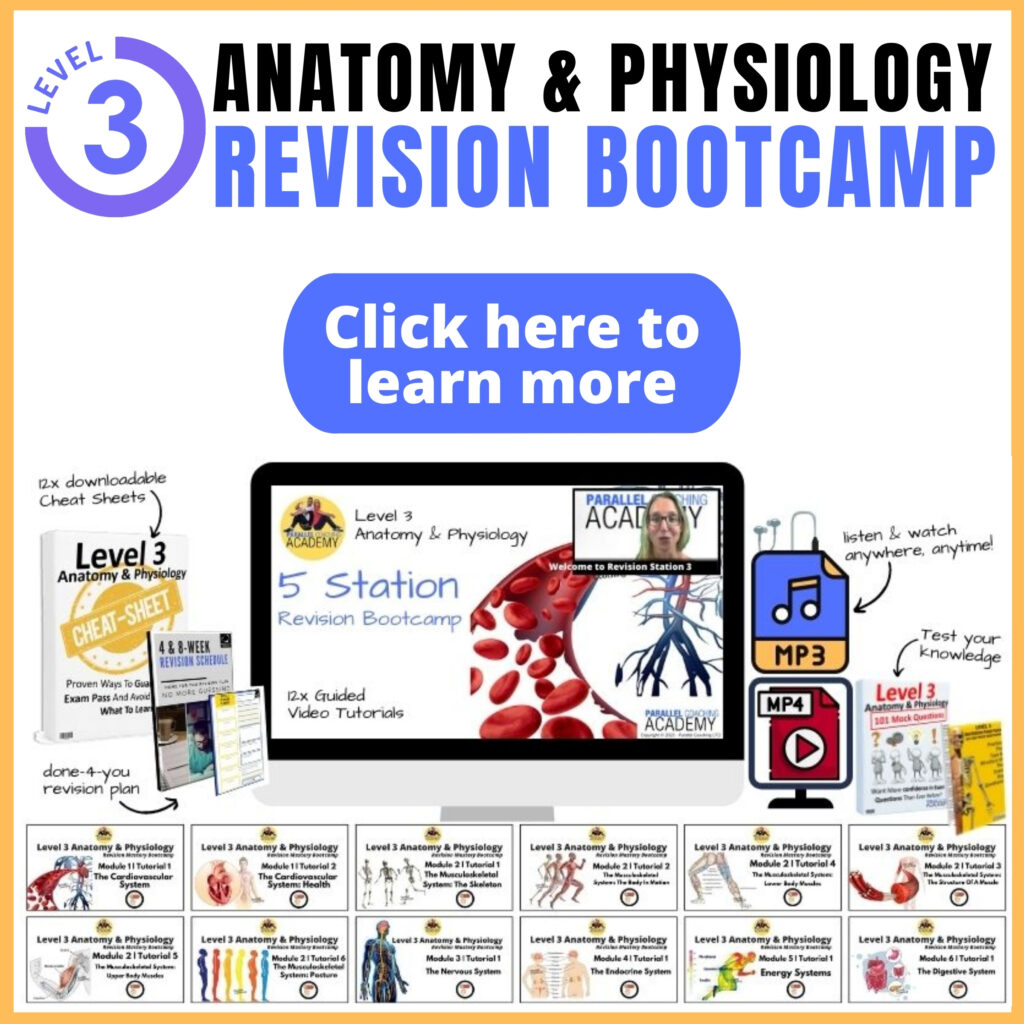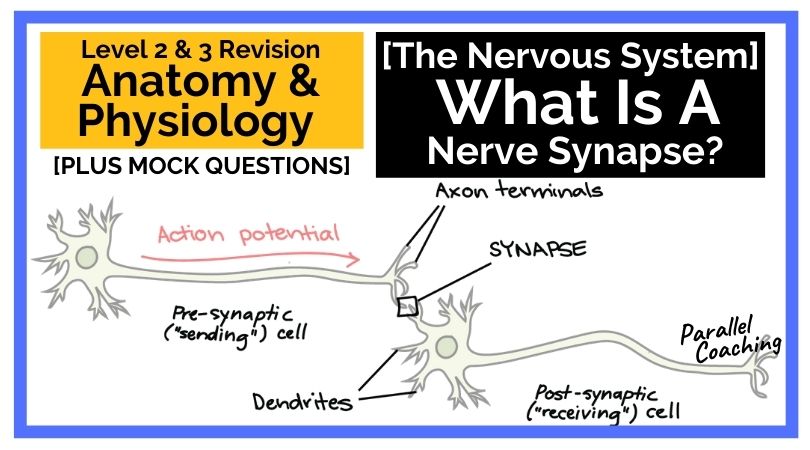In today’s blog, you’ll learn what is nerve synapse and key features and functions of the nervous system to help you prepare for your Level 3 Anatomy and Physiology Exam
You’ll discover:
- Why FITPROs find the nervous system hard to revise
- 9-minute video tutorial explaining What is a Nerve Synapse?
- What is a Nerve Synapse?
- Mock questions to test your knowledge
- How to learn and remember complex anatomy
Why FITPROs find The Nervous System hard to revise
The Nervous System is notoriously claimed to be one of the hardest modules within the Level 3 Anatomy and Physiology syllabus, so you are not alone if you find this area difficult to understand.
It is easy to take movement and bodily actions for granted, as we unconsciously create movement all day every day. It can be difficult to wrap your head around the mechanisms of unconscious control
Although you might not be quoting the individual features of a neurone and explaining the nerve synapse to a client, the knowledge of this, allows you to understand how signals are passed for every action and reaction in our bodies.
This will improve your ability to plan sessions for your client and encourage your client to move efficiently.
9-minute video tutorial explaining What is a Nerve Synapse?
What is A Nerve Synapse?
A nerve synapse is a neural junction
It is the place where two or more nerves meet, and also where nerves end and join to muscles, glands and organs.
The synapse is the chemical transmission of electrical nerve impulses between two nerve cells.
Key features of a neuron structure
This image shows the key features of a neuron structure, you can see the:
- Nucleus – the “brain” of the cell where information entering the cell can be processed.
- Cell Body – the main bulk of the cell. The cell body carries genetic information, maintains the neuron’s structure, and provides energy to drive activities.
- Axon – Neurons generally have one main axon. The axon is a long, tail-like structure that carries information along it’s length. This is key for the transport of information
- Myelin Sheath – Many axons are insulated with a fatty substance called myelin. Myelin helps axons to conduct an electrical signal.
- Dendrites – fibrous roots that branch out from the cell body. Like antennae, dendrites receive and process signals from the axons of other neurons. Neurons can have more than one set of dendrites, known as dendritic trees.
- Axon Terminal – the end of the axon that branches off and forms one end of the synapse
- The synapse – It is the place where two or more nerves meet, and also where nerves end and join nerves to muscles, glands, and organs.
How a nerve functions?
The purpose of a nerve is to send a signal from one part of the body to the other. This could be:
- nerve to nerve,
- from receptor to the brain (afferent neuron)
- or through parts of the spinal cord and brain (inter-neuron)
- or from the brain to muscle, organ, or gland (efferent neuron)
Many nerves join up to send each message or transmission.
It is kinda like a train journey where you need to travel from Edinburgh to Newquay in Conrwall. You don’t just talk one train you, have to get off at a platform and change to a different train multiple times to ensure you get to your destination.
In this analogy the nerve is the train journey whereby an electrical signal is being sent down the nerve cell.
The nerve synapse is the platform, where you change between trains (nerves).
A Nerve (neuron) sends signals using action potentials. An action potential is a shift in the neuron’s electric potential caused by the flow of ions in and out of the neural membrane.
Action potentials can trigger both chemical and electrical synapses.
What is a Nerve Synapse?
At a synapse, one neuron sends a message to a target neuron—another cell.
Most synapses are chemical; these synapses communicate using chemical messengers, other synapses are electrical; for your level 3 anatomy exam, you need to know about chemical synapses and how a message is transmitted across the “synaptic gap”
At a chemical synapse, an action potential triggers the presynaptic neuron to release neurotransmitters. These molecules bind to receptors on the postsynaptic cell and make it more or less likely to fire an action potential
What happens at a Synapse?
Synapses are usually formed between axon terminals on the sending neuron and the cell body or dendrites of the receiving neuron.
Chemical transmission involves release of chemical messengers known as neurotransmitters.
Neurotransmitters carry information from the pre-synaptic (sending) neuron to the post-synaptic (receiving) cell. Heres how it works:
- An action potential travels down the axon of the presynaptic (sending) cell and arrives at multiple axon terminals branching off from the axon.
- Inside the axon terminal of a sending cell are many synaptic vesicles. These are membrane-bound spheres filled with neurotransmitter molecules.
- There is a small gap between the axon terminal of the presynaptic neuron and the membrane of the postsynaptic cell, and this gap is called the synaptic cleft.
- When an action potential, or nerve impulse, arrives at the axon terminal, it activates voltage-gated calcium channels in the cell membrane, releasing neurotransmitters into the synaptic cleft.
- Neurotransmitters bind to receptors on target cell. The molecules of neurotransmitters diffuse across the synaptic cleft and bind to receptor proteins on the postsynaptic cell.
- The sends the signal to the receiving nerve cell so the communication and signal can continue
Test your knowledge with today’s Nerve Synapse mock questions:
[NOTE: The answers are below the 3rd questions]
Q1: Which molecule is released from the synaptic vessel and moves across the synapse to pass on a message to the next nerve?
A. Neurosignallers
B. Caffeine
C. Neurotransmitters
D. Potassium
Q2: What is a synapse?
A. A junction between two nerves
B. A tail-like structure that carries information along it’s length
C. A fatty substance that insulates the axon
D. A junction between two muscle cells
Q3: What is an action potential impulse?
A. Electrical message that moves between nerves
B. Electrical message that moves through a nerve
C. Chemical message that moves through a nerve
D. Chemical message that moves between nerves
Answers to the mock questions are :
Question 1= C, Question 2 = A, Question 3 = C
Download Hundreds of Mock Questions For Free
If you want more mock questions like this, then you can download more Free Mock Questions: DOWNLOAD NOW
Need More Help with your Level 3 Anatomy Revision?
or Trainee FITPROS Taking Their L3 Anatomy & Physiology Exam.
Learn, Revise & Pass Your Level 3 Anatomy & Physiology Exam In Under 10-hours
(Without Having To Spend Hours Revising Or Feeling Overwhelmed)
If you want to get your revision structured, learn everything you need to know and feel confident on exam day, then click the link below:

Dedicated to More
Hayley “Dynamic Stretch For The Pectoralis Major” Bergman
Parallel Coaching
P.S. You can also find us on the following platforms:
Instagram: Follow Now
Facebook: Like Our Page
Twitter: Tweet Us
YouTube: Subscribe Here
More Nervous System Blogs: HERE

